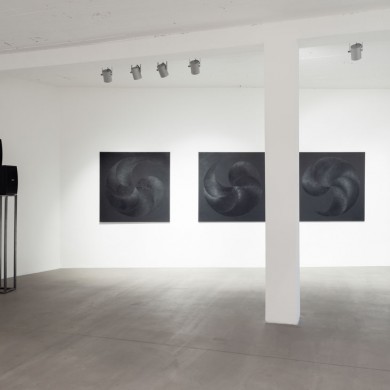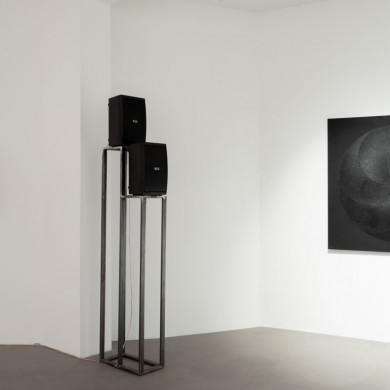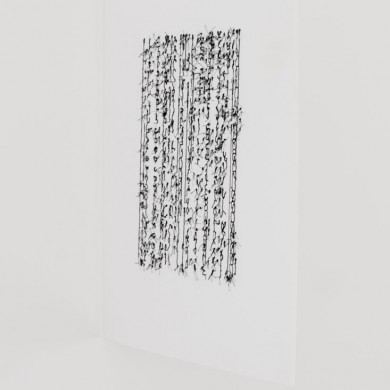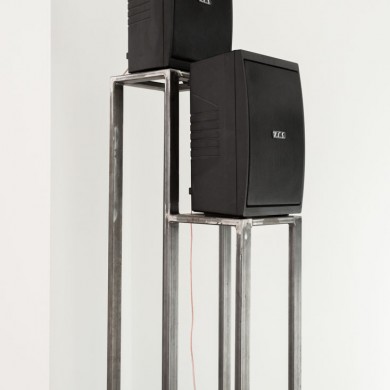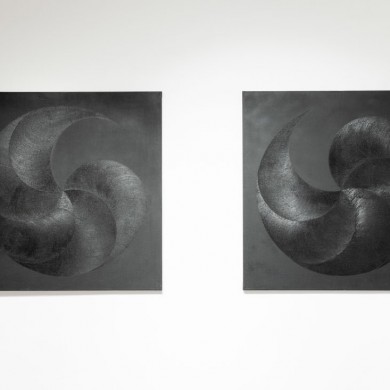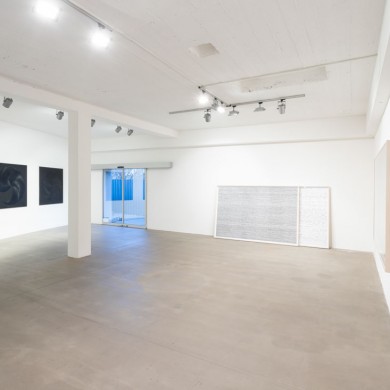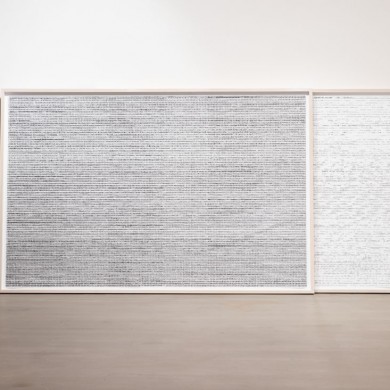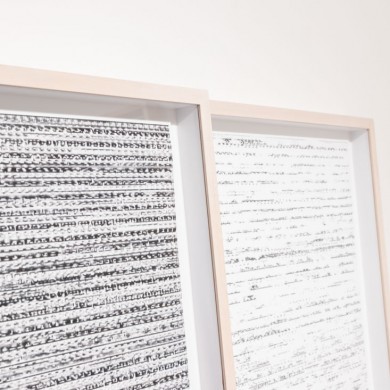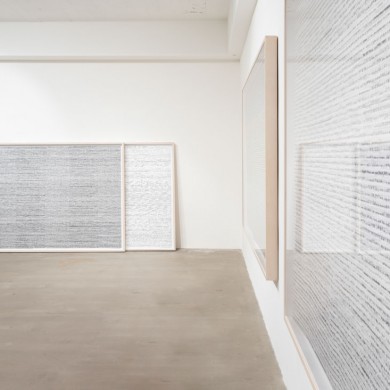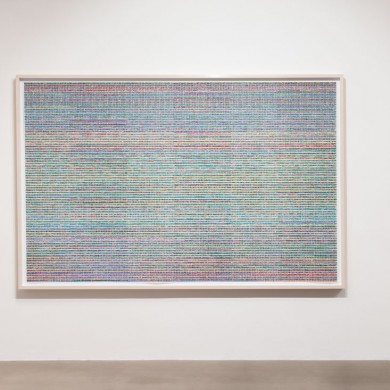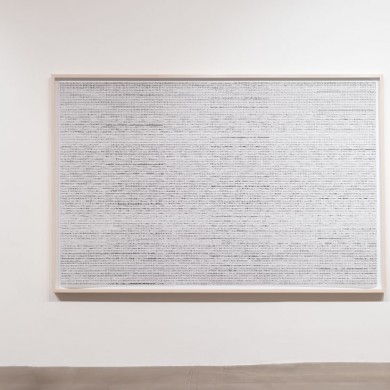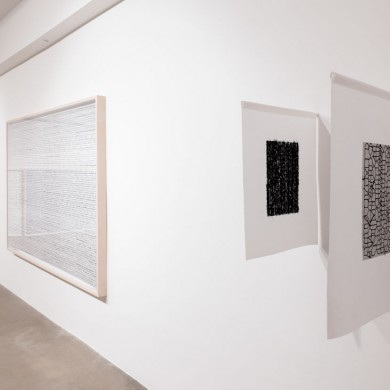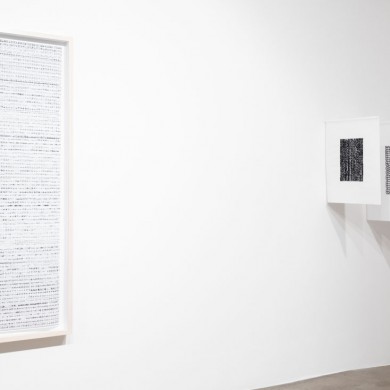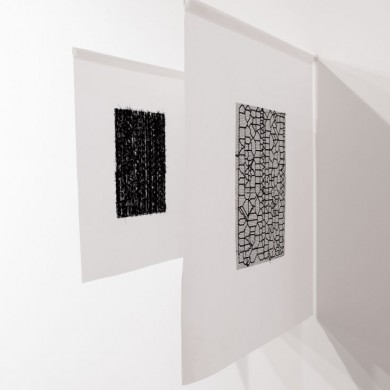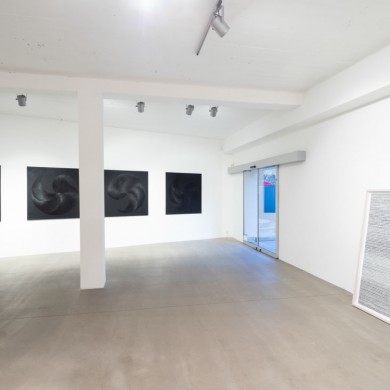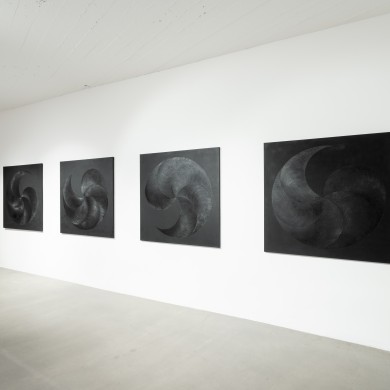Jana Bernartová, Daniel Vlček
curator: Nina Moravcová
17 Feb – 30 March 2023
ZAHORIAN & VAN ESPEN Bratislava
On the Brink of Deep Reverie
On the search for a suitable communication code
“When a system collapses, language is released from its moorings. Words meant to encapsulate reality hang empty in the air, no longer applicable to anything. Textbooks are rendered obsolete overnight and overly complex hierarchies fade away. People suddenly find it difficult to hit upon the right phrasing, to articulate concepts that match their reality.”
On Time and Water, by the Icelandic writer Andri Snær Magnason, opens with these reflections. Magnason writes against the background of specific realia from his country’s recent past. In this respect, his homeland seems to be an extremely precarious place, where much that is concentrated in space and time is sounding with especially great urgency. It is precisely urgency that is the connector between a number of articles which in literary terms are heterogeneous, where the author attempts to convey to us the nature and the importance of the bewildering situation in which we (as humanity) find ourselves. Magnason sketches the nature of the changes we are currently experiencing, using many astonishing stories from the fully-lived lives of his great-grandparents, spanning almost the whole of the 20th century. He refers to the power of these changes, their breakneck speed, and above all, their scarcely imaginable consequences.
“Changes that previously took a hundred thousand years now happen in one hundred. Such speed is mythological; it affects all life on Earth, affects the roots of everything we think, choose, produce, and believe. It affects everyone we know, everyone we love. We are confronted by changes that are more complex than most of what our minds typically deal with. These changes surpass any of our previous experiences, surpass most of the language and metaphors we use to navigate our reality.”
Magnason’s thoughts are not confined to questions connected with climate change, although he addresses those primarily. He also refers to many branches or aspects of human activity which have changed more in the past decade than in the whole of the 20th century. He alludes to unstoppable technological progress and the information congestion associated with it, a characteristic feature of our times. In this connection, he poses the question: with what language or means does one communicate a reality which our minds can only with difficulty contain? He uses an extremely close-fitting comparison, likening these processes to sound recording, which at a certain intensity breaks up in the receivers and is audible only as noise.
Magnason scrutinises the entire situation from the position of the writer, concentrating primarily on written description. However, his thoughts may be applied to communication in general. It seems that visual art, in this context, has potential to communicate, using a broad spectrum of expressive resources. Jana Bernartová and Daniel Vlček draw upon knowledge from various departments of human activity in their artworks. Via their own artistic expressions, or in other words using a special communication code, they attempt to transmit a communicative means that makes considerable demands on our attention, requiring us to be alert and open. To decipher the communication code of their paintings is not a simple matter. The abstracted form, employing recurring motifs, may evoke in us the idea of unidentifiable structures, noise (visual or auditory). But as Daniel Vlček said in one of his interviews, it was his desire for realism, which classical illusive painting did not satisfy, that made him reach for the geometrical ornamental form. Abstract form in a certain sense enabled him to come nearer to realism, contradictory though that might appear.
Vlček’s monochrome paintings from his Spinning Beach Ball series, like his sound installation ironically titled Endless Happiness, were produced for his Further and Higher exhibition in 2015 in the Cabinet T Gallery, situated in the precinct of the former Baťa factory buildings in the centre of Zlín. Interest in the locally specific contact, and a fascination of many years’ standing with the car industry, led Daniel to Barum Continental, a tyre producing factory. The historical context of one of the original Baťa manufacturing plants; its proprietor’s conscious emulation of the visions and principles of Fordism; and the visuality of the products of local serial production: all of these were inspirations for the form of Vlček’s works represented at the exhibition, and for the stratified installation as a whole. Apart from his fascination with the material and the aesthetic of its surface, the artist also brought back from Zlín rather a large quantity of carbon black (the pigment used for colouring tyres) and began using it in his paintings. Although Vlček’s painting has darkened, it still contains the multiple motif of the circle, which hitherto he has been developing in an attempt to register thereby the sonic trace that spreads out in space and time. On this occasion, however, the rotating circular movement offers us an introduction to a different sphere. It evokes the unstoppable cycles of production, which the artist concretises still more by the chosen form and title of his abstract series. With an allusion to an icon informing the user that his operating system is currently at maximum load, the viewer is drawn into the virtual sphere. We are confronted with the limits of a system which, willy-nilly, pulls us into it. There is a flash of awareness, an encounter with an imaginary fissure that enables us to view the situation as a whole. It is a moment of frustration and satisfaction, issuing from consciousness of the limits of the technology that we regard as perfect, and perhaps this is where its dominance over us resides. We are also introduced, however, to the sphere of non-material post-Fordist work, which denies the dualistic temporality of the system that preceded it, blurring the dividing lines between production and consumption, performance and relaxation. Work tools, in these paintings, become ever-present components of ourselves, partners in a highly ambivalent relationship (or to put it more accurately, symbiosis).
The gleaming, mildly wrinkled surface of Vlček’s canvases may evoke an idea of something luxurious and unattainable, stimulating a particular incipient desire, like the continually intensifying sound that pervades the gallery. Irritating, in some sense intimately familiar, persistently filling the entire space with a tension difficult to distinguish, but which after a while we manage to get used to, just like the incessantly changing conditions of work… to be continued… constantly further and higher, beyond the horizon of ordinary days… to the moment when we discover that this is a mere deception, an illusion, whose aim is to keep us in ceaseless movement. Like a well-greased machine, like the gears of a functioning system that generates profit.
Again, we may experience a certain moment of insight on encountering Jana Bernartová’s large-format prints. Thanks to the motif of mirroring, it is as if we ourselves became a conscious part of the data flows which are current everywhere around us, layering themselves in space and time. The fleeting moment of our own reflection seems to become a loophole enabling us to glimpse what is going on in the background of events which we are inseparably part of, and which pervade us, like sound extending through space, and co-define how we experience reality.
Jana Bernartová customarily works in cycles, where for a number of years she has tenaciously explored the potential and limits of pictorial media. Her digital prints from the Grid ZERO series are part of one such cycle, entitled Parametric Digital Structure. It began with a phantom encounter rather like that which Daniel Vlček experienced when looking at the rotating beach ball on his laptop screen. In Bernartová’s case, the mediating agent was an email without content that she received. Via the operating system, she got through to its source code and visualised the data acquired, in the form of large-format digital prints. The initially irritating notes concerning these data, and their frequent comparison to fabrics and carpets, awakened a desire to transfer the information lodged in the background of invisible processes to something truly tangible, to an object that we can touch. She accomplished her aim first of all in a series of small machine- sewn “flags” entitled Grid ZERO # heroines, and subsequently in large-format embroideries. Their eventual form was determined to a certain extent by the sewing machine’s potential and limits. Those served Bernartová, for the moment, as an ancillary variable in the process of recording the digital image, whose form is as ungraspable as the sound vibrations spreading in the air.
It might seem that the form of the paintings presented at the exhibition is defined by the technology chosen: digital print, with potential for the maximum possible format; mechanical movement of the painter’s shoulder, tracing with circular movements a circular pattern in the form of an LP disc or prefab section for such a long time that his mind comes right to the point of meditation, or rather a kind of trance; the mechanised movement of the sewing machine, which in an unguarded moment rewinds the threads in an unforeseen way and totally changes the character of the structure as it was hitherto, perhaps a result of tiredness or an unexpected waking on the brink of deep reverie. Technology is in this instance a directed means, an instrument that is supposed to bring us to a knowledge of something that escapes our understanding, even if what is intended is a gesture of limitation directed against itself.
The visual artist Jana Bernartová (1983) passed through a number of “media” studios in the course of her studies. Her university education commenced at the Faculty of Art and Architecture in the Technical University at Liberec, in Stanislav Zippe’s Studio of Visual Communication – Digital Media. She completed her Master’s Degree in Václav Stratil’s Intermedia Studio at Brno’s FAVU, and her doctorate in Federico Díaz’s Supermedia Studio at UMPRUM in Prague. Her time spent at the university in Liberec was in many ways defining: it provided her with a background of working with the most modern technologies, and a knowledge of their potentialities and limits. The deficiency in the digital image; the tension between the virtual world and lived reality, between data and their material outputs: these represent the core themes of her work hitherto. Jana Bernartová makes her appearance in the contemporary art world not only as artist but equally as a teacher and curator. Since 2016 she has organised the international festival Art Week Liberec. She is Pro-Rector for Studies at the Academy of Fine Arts in Prague.
The painter and musician Daniel Vlček (1978) focuses especially on the artistic combination of sound with his personal visual expression. He visualises a record of sound, vibration, and its expansion in space in subjective pictures, where the emergent shapes are often reminiscent of technical drawings of sound waves. The themes of his works often have to do with researching ecosystems. In recent years he has been fascinated by the world of mushrooms and mycelia, and its significance for our planet. Daniel Vlček is a member of the Guma Guar art grouping and a co-founder of the Prague galleries Berlínskej Model and Ferdinand Bauman Gallery. In the role of curator, he has prepared two group exhibitions devoted to reflection of sound in contemporary visual art (16-20,000 Hz, Meetfactory, Prague, 2013, with M. Vojtěchovský; In the Beginning Was the Silence, Pilsen City Gallery, 2014). He is also engaged in original music production, appearing in the electroacoustic duo Ba:zel, and solo under the name Relaxcore. Daniel Vlček is a graduate of the Academy of Fine Arts in Prague and has studied at the Accademia di Brera in Milan.
Supported using public funding by Slovak Arts Council ![]()
Jana Bernartová, Daniel Vlček
kurátorka: Nina Moravcová
17.2. – 30.3.2023
Zahorian & Van Espen Bratislava
Na pokraji hlbokého snívania
O hľadaní vhodného komunikačného kódu
„Keď sa systémy rúcajú, vyslobodzuje sa jazyk z okov. Slová, ktoré mali vystihovať skutočnosť, zostávajú visieť vo vzduchoprázdne a strácajú platnosť, učebnice cez noc zastarávajú a spoločenská hierarchia sa razom preskupí. Ľudia odrazu s ťažkosťami hľadajú výrazy a pojmy, ktoré by dokázali opísať realitu.“
Touto úvahou začína islandský spisovateľ Andri Snær Magnason prvú kapitolu svojej knihy O čase a vode. Robí tak na pozadí miestne špecifických reálií z nedávnej minulosti svojej krajiny. Jeho domov sa zdá byť v tomto ohľade tým najpríhodnejším miestom, kde mnohé, koncentrované v priestore a v čase, zaznieva s oveľa väčšou naliehavosťou. Práve táto naliehavosť je spojnicou niekoľkých literárne nesúrodých statí a ňou sa nám snaží priblížiť povahu a závažnosť neprehľadnej situácie, v ktorej sme sa (ako ľudstvo) ocitli. Povahu zmien, ktoré práve zažívame, vykresľuje prostredníctvom mnohokrát neuveriteľných príbehov naplnených životov svojich starých rodičov preklenujúcich takmer celé dvadsiate storočie. Poukazuje na ich silu, prudkú rýchlosť, ale predovšetkým ťažko predstaviteľné dôsledky.
„Zmeny, ktoré kedysi prebiehali po státisíce rokov, sa teraz odohrávajú iba za storočie. Taká rýchlosť je doslova mýtická. Dotýka sa všetkého života na Zemi a koreňov všetkého, o čom premýšľame, čo si vyberáme, čo vyrábame a čomu veríme. Zasahuje všetkých, ktorých poznáme, aj všetkých tých, ktorých milujeme. Zmeny, s ktorými sa stretávame, sú zložitejšie ako väčšina bežných problémov, s akými si naša myseľ dokáže poradiť. Presahujú všetku našu predchádzajúcu skúsenosť. Náš jazyk a metafory, ktoré využívame na pochopenie skutočnosti, na ňu väčšinou nestačia.“
Magnasonove úvahy sa netýkajú len otázok spojených s premenou klímy, hoci na tie sa zameriava primárne. Poukazuje aj na mnohé odvetvia či aspekty ľudskej činnosti, ktoré sa za posledné desaťročie premenili viac ako za celé dvadsiate storočie. Naráža na nezastaviteľný technologický pokrok a s ním spojené zahltenie informáciami – charakteristický rys našej súčasnosti. V tejto súvislosti si kladie otázku, akým jazykom či spôsobom komunikovať skutočnosti, ktoré naša myseľ dokáže len ťažko obsiahnuť. Používa viac ako priliehavé prirovnanie, keď tieto procesy porovnáva s nahrávaním zvuku, ktorý sa pri určitej intenzite v prijímačoch láme a je počuteľný iba ako šum.
Autor nazerá na celú situáciu z pozície spisovateľa, sústredí sa teda predovšetkým na slovný opis. Jeho úvahy sa ale dajú aplikovať na komunikáciu všeobecne. Zdá sa, že vizuálne umenie má v tomto ohľade možnosť komunikovať pomocou širšieho spektra výrazových prostriedkov. Jana Bernartová aj Daniel Vlček vo svojej umeleckej tvorbe čerpajú poznatky z rôznych odborov ľudskej činnosti. Prostredníctvom vlastného umeleckého vyjadrenia, teda iného komunikačného kódu, sa snažia sprostredkovať informácie, ktoré kladú značné nároky na našu pozornosť, vyžadujú naše zbystrenie a otvorenosť. Dešifrovať komunikačný kód ich obrazov nie je jednoduché. Abstrahovaná forma využívajúca opakujúce sa motívy v nás môže vyvolávať predstavu nečitateľných štruktúr, šumu – vizuálneho či zvukového. Ako však Daniel Vlček v jednom rozhovore spomenul, po geometrickej ornamentálnej forme siahol z túžby po realizme, ktorý klasická iluzívna maľba nenapĺňala. Naopak abstraktná forma mu umožnila sa k nemu v istom zmysle dostať bližšie.
Vlčkove monochrómne maľby zo série Spinning Beach Ball, rovnako ako zvuková inštalácia s ironickým názvom Endless Happiness, vznikli pre výstavu Ďalej a vyššie uvedenú v roku 2015 v galérii Kabinet T v areáli budov bývalých baťovských závodov v centre Zlína. Záujem o miestne špecifický kontext a mnohoročná fascinácia automobilovým priemyslom vtedy Daniela zaviedli do závodu na výrobu pneumatík Barum Continental. Práve historický kontext jedného z pôvodne baťovských výrobných podnikov, vedomé odvolávanie sa jeho majiteľa na vízie a princípy fordizmu, ale aj vizuálnosť produktov tunajšej sériovej výroby podnietili podobu Vlčkových diel zastúpených na výstave, aj vrstevnatej inštalácie ako celku. Okrem fascinácie materiálom a estetikou jeho povrchu si vtedy autor zo Zlína priviezol aj väčšie množstvo sadzí – pigmentu, ktorý sa používa na farbenie pneumatík – a začal ho využívať vo svojich maľbách. Hoci Vlčkov obraz sčernel, multiplikovaný motív kruhu, ktorý doposiaľ vo svojej práci rozvíjal v snahe zaznamenať prostredníctvom neho zvukovú stopu šíriacu sa v priestore a čase, v ňom zostal. Tentokrát nás ale rotujúci kruhový pohyb zavádza do inej sféry. Evokuje nezastaviteľné kolesá produkcie, ktorú autor zvolenou formou aj názvom svojej abstraktnej série ešte viac konkretizuje. Odkazom na ikonu informujúcu používateľa, že jeho operačný systém je aktuálne plne vyťažený, vťahuje diváka do virtuálnej sféry. Konfrontuje nás s limitmi systému, do ktorého sme chtiac – nechtiac vtiahnutí. Tento moment pôsobí ako okamih „zvedomenia“, stretnutia s pomyselnou trhlinou, ktorá nám umožňuje na celú situáciu nahliadnuť. Je momentom frustrácie aj zadosťučinenia plynúceho z vedomia limitov technológie, ktorú považujeme za dokonalú, a možno práve v tom má nad nami nadvládu. Zavádza nás však aj do sféry nehmotnej postfordistickej práce popierajúcej dualistickú temporálnosť systému, ktorý jej predchádzal, v ktorej sa stierajú hranice medzi produkciou a spotrebou, výkonom a odpočinkom. Práca, v ktorej sa pracovné nástroje stávajú našou všadeprítomnou súčasťou, partnermi v často ambivalentnom vzťahu, či skôr symbióze.
Lesklý, jemne zvrásnený povrch Vlčkových plátien navyše môže evokovať predstavu niečoho luxusného, nedosiahnuteľného, podnecovať zdanie špecifickej túžby rovnako ako neustále stúpajúci tón prestupujúci galériu. Iritujúci, v niečom dôverne známy, vypĺňajúci celý priestor ťažko postihnuteľným napätím, na ktoré si ale po chvíli dokážeme zvyknúť, rovnako ako na neustále sa premieňajúce pracovné podmienky. … to be continued… stále ďalej a vyššie, za horizont všedných dní… až do chvíle, keď zistíme, že ide o obyčajný klam, ilúziu, ktorej cieľom je udržať nás v neustálom pohybe. Ako dobre namazaný stroj, ako súkolesie funkčného systému generujúceho zisk.
Istý moment prezrenia môžeme zažiť aj pri stretnutí s veľkoformátovou digitálnou tlačou Jany Bernartovej. Vďaka motívu zrkadlenia akoby sme sa sami stali vedomou súčasťou dátových tokov, ktoré prúdia všade okolo nás, vrstvia sa v priestore i čase. Prchavý okamih vlastného odrazu akoby sa stal štrbinou umožňujúcou zahliadnuť, čo sa odohráva na pozadí dejov, ktorých sme neoddeliteľnou súčasťou, ktoré nás, podobne ako zvuk šíriaci sa priestorom, prestupujú a spoludefinujú naše prežívanie reality.
Jana Bernartová je zvyknutá pracovať v cykloch, počas ktorých tvrdošijne niekoľko rokov skúma možnosti a limity zobrazovacieho média. Digitálne tlače zo série Raster NULA sú súčasťou jedného z nich – cyklu s názvom Parametrická digitálna štruktúra. Na jeho počiatku stálo podobné fantómové stretnutie, iniciácia blízka tej, akú zažil Daniel Vlček pri pohľade na rotujúcu plážovú loptu na obrazovke svojho laptopu. V autorkinom prípade ju sprostredkoval prijatý email bez obsahu. Cez operačný systém prenikla k jeho zdrojovému kódu a získané dáta vizualizovala do podoby veľkoformátových digitálnych tlačí. Spočiatku iritujúce poznámky na ich adresu a časté prirovnania k látkam a kobercom v nej prebudili túžbu pokúsiť sa previesť informácie stojace v pozadí neviditeľných procesov do niečoho naozaj hmatateľného, do objektu, ktorého sa môžeme dotknúť. Svoj zámer realizovala najskôr v sérii drobných strojom vyšívaných „vlajok“ s názvom Raster NULA # hrdinky, následne vo veľkoformátových výšivkách. Ich výslednú podobu do istej miery definovali možnosti a limity vyšívacieho stroja, ktoré sa tentoraz stali pre Bernartovú pomocnou premennou v procese zaznamenania digitálneho obrazu, ktorého podoba je podobne neuchopiteľná ako zvuková vibrácia šíriaca sa vzduchom.
Mohlo by sa zdať, že podoba obrazov predstavených na výstave je definovaná zvolenou technológiou – digitálnou tlačou s možnosťou maximálneho možného formátu; mechanickým pohybom maliarovho ramena, ktoré krúživými pohybmi obkresľuje kruhovú šablónu v podobe LP platne alebo prefabrikovaného dielca tak dlho, až sa jeho myseľ dostane na hranicu meditácie či skôr určitého tranzu; mechanizovaným pohybom vyšívacieho stroja, ktorý v nestráženej chvíli previnie nečakaným spôsobom nite a úplne zmení charakter doterajšej štruktúry – azda pod vplyvom únavy alebo nečakaného precitnutia na pokraji hlbokého snívania. Technológia je v tomto prípade riadeným prostriedkom, nástrojom, ktorý nás má priviesť k poznaniu niečoho, čo uniká nášmu pochopeniu, a to aj v prípade, ak by malo ísť o gesto vymedzenia sa voči nej samotnej. / Nina Moravcová
Vizuálna umelkyňa Jana Bernartová (1983) počas štúdií prešla niekoľkými „mediálnymi“ ateliérmi. Vysokoškolské vzdelanie začala na Fakulte umenia a architektúry Technickej univerzity v Liberci v ateliéri Vizuálna komunikácia – digitálne médiá Stanislava Zippeho. Magisterské štúdium absolvovala v intermediálnom ateliéri Václava Stratila na brnianskej FAVU, doktorát v ateliéri Supermédia Federica Díaza na pražskej UMPRUM. V mnohých ohľadoch bolo pre ňu definujúce už pôsobenie na libereckej univerzite, ktoré jej poskytlo zázemie pre prácu s najmodernejšími technológiami, znalosť ich možností i limitov. Práve chyba v digitálnom obraze, napätie medzi virtuálnym svetom a prežívanou realitou, medzi dátami a ich hmotnými výstupmi predstavujú nosné témy jej doterajšej tvorby. Jana Bernartová do sveta súčasného umenia vstupuje nielen z pozície umelkyne, ale aj pedagogičky a kurátorky. Od roku 2016 organizuje medzinárodný festival Art Week Liberec. Je prorektorkou pre študijné záležitosti Akadémie výtvarných umení v Prahe.
Maliar a hudobník Daniel Vlček (1978) sa vo svojej tvorbe zameriava obzvlášť na prepojenie zvuku a vlastného vizuálneho prejavu. Záznam zvuku, vibrácie a ich šírenie v priestore vizualizuje v subjektívnych obrazcoch, pričom vzniknuté tvary často pripomínajú technické kresby zvukových vĺn. Samotné témy jeho diel sa často vzťahujú k prieskumu ekosystémov. V posledných rokoch je fascinovaný svetom húb a podhubí a ich významom pre našu planétu. Daniel Vlček je členom umeleckej skupiny Guma guar a spoluzakladateľom pražských galérií Berlínskej model a Galerie Ferdinanda Baumana. V roli kurátora pripravil dvojicu skupinových výstav venovaných reflexii zvuku v súčasnom vizuálnom umení (16-20,000 Hz, Meetfactory, Praha, 2013, spolu s M. Vojtechovským; Na počiatku bolo ticho, Galerie mesta Plzně, 2014). Venuje sa vlastnej hudobnej produkcii – vystupuje v elektroakustickom duu Ba:zel a samostatne pod menom Relaxcore. Je absolventom Akadémie výtvarných umení v Prahe. Študoval tiež na Accademia di Brera v Miláne.
